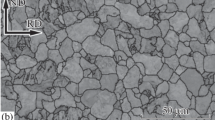Abstract
We investigate the effects of the chemical and phase compositions of grain boundaries and the state of an excess phase on the fracture toughness, cold brittleness, and strength of low-alloyed molybdenum by the methods of scanning electron microscopy, transmission electron microscopy, and Auger electron spectroscopy. The structural state of the material was changed without changing grain sizes by annealing in various modes at different temperatures. It was shown that the level of segregation of interstitials on grain boundaries is determined by both the annealing temperature and distinctive features of the evolution of excess phases. Embrittlement of grain boundaries results in a decrease in the strength and fracture toughness of the material and in an increase in its temperature of cold brittleness. In the case of transcrystalline fracture, the material exhibits better mechanical properties correlated with distinctive features of the evolution of excess phases inside the grains.
Similar content being viewed by others
References
A. Kumar and B. L. Eyre, “Grain boundary segregation and intergranular fracture in molybdenum,”Proc. Roy. Soc. (London),A370, No. 1743, 431–458, (1980).
A. S. Drachinskii, S. N. Kaverina, A. V. Krainilov, et al., “On chemical and phase inhomogeneity and causes of intergranular brittleness of molybdenum alloys. I. Effect of the evolution of structure in the process of annealing on grain-boundary segregation of interstitials,”Fiz. Met. Metalloved., No. 8, 97–102 (1990).
A. S. Drachinskii, A. V. Krainilov, and V. N. Slyunyaev, “On chemical and phase inhomogeneity and causes of intergranular brittleness of molybdenum alloys. II. Effect of segregation of admixtures and carbide precipitations on the embrittlement of grain boundaries,”Fiz. Met. Metalloved., No. 9, 102–107 (1990).
D. Briggs and M. P. Seach (editors),Practical Surface Analysis by Auger and X-Ray Photoelectron Spectroscopy Wiley, Chichester-New York-Brisbane-Toronto-Singapore (1983).
T. Sekine, K. Hirata, and A. Mogami, “Matrix effect correction in quantitative Auger electron spectroscopy,”Surf. Sci. 125, 565–574 (1983).
M. P. Seach and W. A. Dench, “Quantitative electron spectroscopy of surfaces: A standard data base fer electron elastic mean free paths in solids,”Surf. Interf. Anal. 1, No. 1, 2–11 (1979).
T. Sekine, Y. Nagasawa, M. Kudoh, et al.,Handbook of Auger Electron Spectroscopy JEOL Ltd., Tokyo (1982).
J. M. Lang, U. Dahmen, and K. H. Westmacott, “The origin of Mo2C precipitate morphology in molybdenum,”Phys. Stat. Sol. A75, No. 2, 409–420 (1983).
V. N. Eremenko, G. Ya. Velikanova, and L. V. Artyukh,Triple Systems of Molybdenum with Carbon and IV-Group Transition Metals [in Russian], Naukova Dumka, Kiev (1985).
A. S. Drachinskii, Yu. N. Podrezov, and V. I. Trefilov, “Influence of structural elements on the energy of intergranular fracture,”Fiz. Met. Metalloved., No. 1, 157–164 (1983).
K. Hayashi and S. Nemat-Nasser, “Energy release rate and crack kinking,”Int. J. Solids Struct. 17, No. 1, 107–116 (1981).
F. Ebrahimi, “Probability of intergranular fracture in intrinsically brittle materials,”Scr. Met. Mater. 25, No. 7, 1737–1740 (1991).
V. V. Rybin, Yu. F. Titovets, A. N. Vergazov, et al., “Low-angle grain boundaries in polycrystals,”Poverkhn.: Fiz., Khim., Mekh., No. 6, 84–90 (1986).
W. Missol,Energy of the Phase Boundary in Metals [Russian translation], Metallurgiya, Moscow (1978).
A. S. Drachinskii, “On the diversity of the causes of intergranular fracture,”Fiz. Met. Metalloved., No. 3, 598–604 (1983).
O. I. Ban'kovskii, A. D. Vasil'ev, A. Yu. Koval', et al., “Fracture toughness of a molybdenum sheet in the course of the transition from the brittle state to the plastic state,” in:Electron Microscopy and Strength of Materials Institute for Problems in Materials Science, Ukrainian Academy of Sciences, Kiev (1989), pp. 52–58.
G. F. Knott,Fundamentals of Fracture Mechanics Butterworths, London (1974).
Author information
Authors and Affiliations
Additional information
Translated from Fiziko-Khimicheskaya Mekhanika Materialov, Vol. 30, No. 5, pp. 34–44, September–October, 1994.
Rights and permissions
About this article
Cite this article
Drachinskii, A.S., Krainikov, A.V., Slyunyaev, V.N. et al. Effect of the structural state on the cold brittleness and fracture toughness of low-alloyed molybdenum. Mater Sci 30, 556–566 (1995). https://doi.org/10.1007/BF00569551
Received:
Issue Date:
DOI: https://doi.org/10.1007/BF00569551




